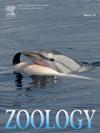Variations of larval ommatidia in four species of Bittacidae (Insecta: Mecoptera)
IF 1.6
3区 生物学
Q2 ZOOLOGY
引用次数: 0
Abstract
The larvae of Bittacidae normally bear a pair of compound eyes on the lateral sides of the head. The compound eyes each are reported to consist of seven ommatidia. However, whether the eyes have variations in number among species and individuals remain unclear to date. Here, ommatidial variations of compound eyes were investigated in four species of Bittacidae larvae using light microscopy. The results show that the number of ommatidia remains constant for a larval eye across instars of the same larva, but numerical variations of ommatidia were found for different individuals and different species of Bittacidae. The compound eyes of larvae each consist of six to ten ommatidia in the most widely distributed Bittacus cirratus Tjeder, but are composed of seven to nine ommatidia in B. planus Cheng and B. lii Zhou, and seven to eight ommatidia in Terrobittacus longisetus Tan & Hua. Seven ommatidia are the most common number, likely representing the ground plan of larval compound eyes in Bittacidae. The distribution patterns of ommatidia can be categorized into five types. The significance of larval ommatidial variation of Bittacidae is briefly discussed with behavior of larvae and evolution of visual organs of holometabolous larvae.
四种蠓科幼虫小孔虫的变异(昆虫纲:鞘翅目)
刺蚊科的幼虫通常在头部侧面长有一对复眼。据报道,每个复眼由七个小眼组成。然而,到目前为止,眼睛在物种和个体之间是否有数量上的差异仍不清楚。本文用光学显微镜研究了四种蠓科幼虫复眼的基本形态变化。结果表明,同一幼虫不同龄期的幼虫眼内小眼的数量保持不变,但不同个体和不同种的幼虫眼内小眼的数量存在差异。在分布最广的卷腹圆蝽幼虫复眼中,每只复眼由6 ~ 10个小眼组成,而平腹圆蝽和周氏圆蝽幼虫复眼由7 ~ 9个小眼组成,长角圆蝽幼虫复眼由7 ~ 8个小眼组成;华。7个小眼是最常见的数目,可能代表了蠓科幼虫复眼的地面平面。小虫的分布模式可分为五种类型。本文从幼虫的行为和全变异幼虫视觉器官的进化等方面简要讨论了双翅目昆虫幼虫形态变异的意义。
本文章由计算机程序翻译,如有差异,请以英文原文为准。
求助全文
约1分钟内获得全文
求助全文
来源期刊

Zoology
生物-动物学
CiteScore
3.90
自引率
0.00%
发文量
37
审稿时长
70 days
期刊介绍:
Zoology is a journal devoted to experimental and comparative animal science. It presents a common forum for all scientists who take an explicitly organism oriented and integrative approach to the study of animal form, function, development and evolution.
The journal invites papers that take a comparative or experimental approach to behavior and neurobiology, functional morphology, evolution and development, ecological physiology, and cell biology. Due to the increasing realization that animals exist only within a partnership with symbionts, Zoology encourages submissions of papers focused on the analysis of holobionts or metaorganisms as associations of the macroscopic host in synergistic interdependence with numerous microbial and eukaryotic species.
The editors and the editorial board are committed to presenting science at its best. The editorial team is regularly adjusting editorial practice to the ever changing field of animal biology.
 求助内容:
求助内容: 应助结果提醒方式:
应助结果提醒方式:


